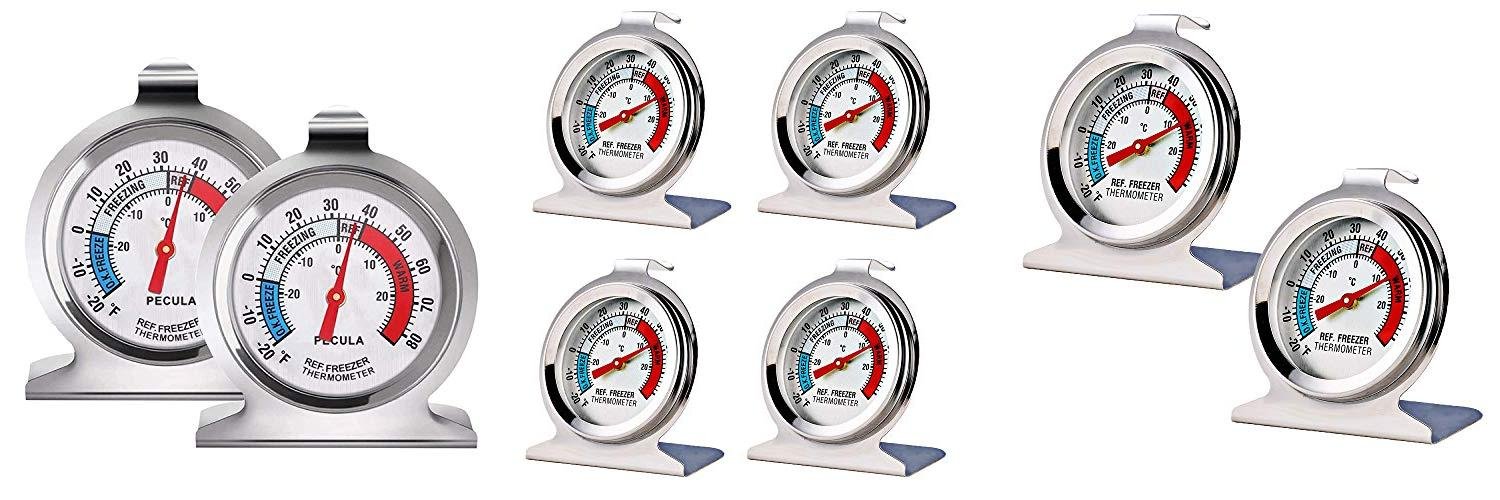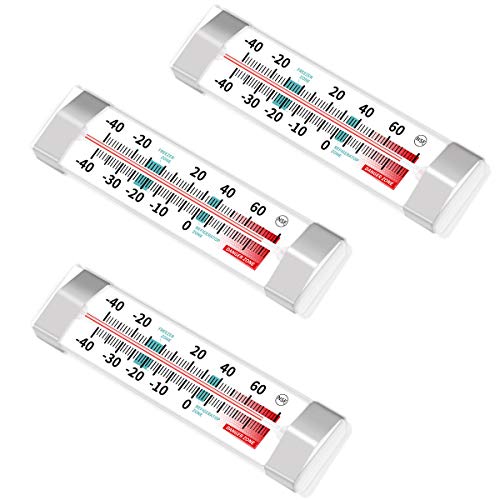Ever pulled out a rock-solid ice cream scoop, or worse, found your milk a little… sour? These kitchen mishaps probably mean your refrigerator and freezer temperatures aren’t quite right. Setting the perfect chill is more important than you might think!
Choosing the best temperature for your refrigerator and freezer can be tricky. Too warm, and your food spoils quickly. Too cold, and you waste energy and risk freezer burn. Finding the sweet spot saves you money, keeps your food safe, and makes sure everything tastes its best. Avoiding food waste is super important, and knowing how to adjust your fridge can help you do that.
In this post, we’ll unlock the secrets to perfect food storage. You’ll learn the ideal temperatures for your fridge and freezer. We’ll also cover how to check your appliances and troubleshoot common problems. By the end, you’ll be a temperature expert, keeping your food fresh and your family safe. Let’s dive in and get your fridge and freezer working at their best!
Our Top 5 Temperature For Refrigerator Freezer Recommendations at a Glance
Top 5 Temperature For Refrigerator Freezer Detailed Reviews
1. 2 Pack Refrigerator Thermometer
Rating: 9.3/10
Keep your food fresh and safe with the 2 Pack Refrigerator Thermometer! This handy device helps you monitor the temperature inside your fridge and freezer. It has a large, easy-to-read dial with clear temperature markings. The thermometer works well in traditional refrigerators, freezers, and coolers. Its simple design means no batteries are needed, making it a convenient addition to your kitchen.
What We Like:
- Clear and easy to read temperature dial with blue and red zones.
- Measures a wide temperature range to suit different needs.
- The thermometer is easy to use and can be hung or placed anywhere.
- Made of strong stainless steel and a glass lens for long-lasting use.
- You get two thermometers in the pack, plus good customer service.
What Could Be Improved:
- The design is simple, so it may not be as stylish as some digital options.
This 2 Pack Refrigerator Thermometer is a practical and affordable way to keep your food at the right temperature. It is a useful tool for any kitchen.
2. 4 Pack Refrigerator Freezer Thermometer Large Dial Analog Thermometer
Rating: 8.8/10
Keep your food fresh with the 4 Pack Refrigerator Freezer Thermometer! These thermometers help you monitor the temperature inside your fridge and freezer. They have a large dial that is easy to see. They are made of strong stainless steel. You can place them anywhere you like. The wide base and hook make it easy to install. Each pack includes four thermometers to keep your food safe.
What We Like:
- Easy to read. You can see the temperature quickly.
- Made from stainless steel. This makes them strong and durable.
- Simple to install. The wide base and hook give you options.
- Measures a wide range of temperatures. It can measure from -20 to 80℉.
- Great value. You get four thermometers in one pack.
What Could Be Improved:
- Analog display. Some people might prefer a digital thermometer.
These thermometers are a good way to check your fridge and freezer temperatures. They are a simple and effective solution for keeping your food at the right temperature.
3. 2 Pack Refrigerator Freezer Thermometer Large Dial Analog Thermometer
Rating: 9.3/10
Keep your food safe and fresh with the 2 Pack Refrigerator Freezer Thermometer! This handy tool helps you monitor the temperature inside your fridge and freezer. It has a large, easy-to-read dial. The thermometer measures temperatures from -20 to 80℉. Made from strong stainless steel, it is built to last. You can easily place it anywhere in your refrigerator with its wide base or hang it with the built-in hook. This 2-pack offers great value for your money.
What We Like:
- Easy to read! The large dial makes it simple to see the temperature at a glance.
- Made from stainless steel. This means the thermometer is durable and strong.
- Two thermometers included! You get a pair, which is great for both your fridge and freezer.
- Flexible installation. You can place the thermometer on a shelf or hang it.
- Accurate temperature readings. Keep your food at the right temperature.
What Could Be Improved:
- The analog display might not be as precise as a digital one.
Overall, this 2 Pack Refrigerator Freezer Thermometer is a smart buy for any kitchen. It is a simple and effective way to ensure your food stays at the correct temperature.
4. Fridge Refrigerator Freezer Thermometer (3pack)
Rating: 9.4/10
Keep your food safe with the Fridge Refrigerator Freezer Thermometer (3pack)! This handy set helps you monitor temperatures in your fridge and freezer. It features a wide temperature range, so you can check both cold and freezer temperatures. The thermometers are made of plastic and stainless steel. They are easy to install and give you an accurate reading. This three-pack offers a cheap and simple way to keep your food at the right temperature.
What We Like:
- Good quality thermometers.
- Easy to put in your fridge and freezer.
- The price is cheap.
- They show both Fahrenheit and Celsius.
What Could Be Improved:
- The plastic material could be more durable.
Overall, the Fridge Refrigerator Freezer Thermometer (3pack) is a great value. It is a simple and affordable way to make sure your food stays fresh.
5. Smart Wireless Temperature/Humidity Sensor Wide Range for Freezer Fridge Monitoring Pet Cage/Tank Monitoring
Rating: 8.7/10
Keep track of temperature and humidity with the Smart Wireless Temperature/Humidity Sensor! This handy 2-pack comes with a hub. It’s perfect for monitoring your fridge, freezer, pet cages, and more. The sensors use a special long-range technology that’s better than Wi-Fi. They work far away and can even go inside metal boxes. You’ll get alerts on your phone, by text, or email if things change. It also works with Alexa and IFTTT!
What We Like:
- Long-range sensors work even in tough spots like a fridge or outside.
- Easy to set up with a quick plug-and-play design.
- You get alerts via text, email, and phone notifications.
- Works with Alexa and IFTTT for cool automation.
- Saves money by making any fridge smart.
What Could Be Improved:
- SMS messages are limited.
- Humidity readings aren’t supported by Alexa yet.
This sensor kit is a smart choice for keeping an eye on temperature and humidity. It’s easy to use and keeps you informed.
Cool Choices: Your Refrigerator Freezer Guide
Choosing the right refrigerator freezer is a big deal. You want to keep your food fresh and safe. This guide helps you pick the best one for you.
Key Features to Look For
Here are the important things to think about:
- Size (Capacity): How much food do you need to store? Measure the space in your kitchen. Then, choose a refrigerator that fits. A family of four needs more space than a single person.
- Type: There are different types of refrigerators.
- Top Freezer: These are often the most affordable. The freezer is on top.
- Bottom Freezer: The freezer is on the bottom. Many people find this easier to use.
- Side-by-Side: The refrigerator and freezer are side by side.
- French Door: This has two doors for the refrigerator and a bottom freezer.
- Temperature Controls: Look for adjustable temperature controls. This allows you to set the right temperature. You can also control the freezer temperature.
- Energy Efficiency: Look for the Energy Star label. This means the refrigerator uses less energy. This saves you money on your electric bill.
- Special Features: Some refrigerators have extra features. These can include ice makers, water dispensers, and smart technology.
Important Materials
The materials used matter for durability and performance:
- Exterior: Stainless steel is a popular choice. It looks nice and is easy to clean. Other options include black or white finishes.
- Shelves: Glass shelves are common. They are easy to clean and strong.
- Insulation: Good insulation keeps the cold air inside. This makes your refrigerator work better.
Factors That Improve or Reduce Quality
Things that make a refrigerator better or worse:
- Good Quality:
- Reliable Compressor: The compressor is the heart of the refrigerator. A good one lasts a long time.
- Strong Seals: The door seals need to be tight. This keeps cold air in and warm air out.
- Durable Materials: Quality materials last longer.
- Consistent Temperature: The refrigerator should keep a steady temperature.
- Poor Quality:
- Weak Compressor: This can break down quickly.
- Poor Insulation: This makes the refrigerator work harder.
- Cheap Materials: These can break or wear out fast.
- Unstable Temperature: This can spoil your food.
User Experience and Use Cases
Think about how you will use the refrigerator:
- Daily Use: How often do you open the door? Do you need easy access to certain items?
- Food Storage: Consider how much fresh food and frozen food you buy.
- Cleaning: How easy is it to clean the shelves and drawers?
- Placement: Make sure the refrigerator fits in your kitchen. Leave space around it for air circulation.
Frequently Asked Questions
Q: What is the ideal temperature for a refrigerator?
A: The ideal temperature is usually between 37°F and 40°F (3°C and 4°C).
Q: What is the ideal temperature for a freezer?
A: The ideal temperature is 0°F (-18°C).
Q: How do I check my refrigerator’s temperature?
A: Use a refrigerator thermometer. Place it in a glass of water inside the refrigerator and freezer.
Q: Why is my refrigerator not cold enough?
A: Check the temperature settings. Make sure the door seals are tight. Don’t overpack the refrigerator.
Q: Why is my freezer not cold enough?
A: Check the temperature settings. Make sure the door seals are tight. The freezer could be too full.
Q: How often should I clean my refrigerator?
A: Clean your refrigerator regularly. Wipe up spills immediately. Clean it thoroughly every few months.
Q: How do I defrost my freezer?
A: Some freezers are automatic. Others need to be defrosted manually. Follow the instructions in your manual.
Q: What should I do if my refrigerator stops working?
A: Check the power cord. Make sure the outlet works. If it still doesn’t work, call a repair technician.
Q: How can I save energy with my refrigerator?
A: Make sure the door seals are tight. Don’t leave the door open for too long. Keep the refrigerator full.
Q: Where can I find the temperature settings on my refrigerator?
A: Look for the temperature controls inside the refrigerator. They are usually on the top or on the front.
In conclusion, every product has unique features and benefits. We hope this review helps you decide if it meets your needs. An informed choice ensures the best experience.
If you have any questions or feedback, please share them in the comments. Your input helps everyone. Thank you for reading.

My name is Gary Flores, the creator of deepskyblue-owl-132507.hostingersite.com.. With a passion for creating cozy, functional, and beautiful spaces, I share my personal experiences and expertise about everything related to home improvement. From practical tips to design inspiration, my goal is to help you make your home the best it can be.





